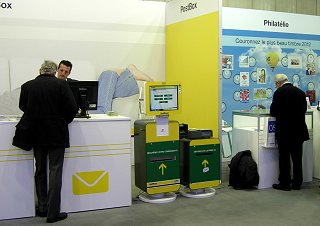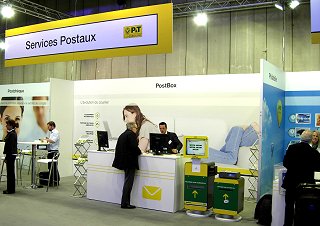|
 |
 |
L'Administration des Postes de Luxembourg was created in 1842. The first stamp was issued ten years later and, in 1874, Luxembourg became one of the founding members of the Universal Postal Union.
The public company, Entreprise des Postes et Télécommunications or P&TLuxembourg, was created in 1992. It is the first postal and telecommunications operator of the Grand Duchy.
P&TLuxembourg currently has a network of over 100 post offices and postshops, serving a population of just over half a million inhabitants. |
| P&TLuxembourg building in the centre of the capital |
Always on top of the latest technological developments, P&TLuxembourg was, in 2010, the first European postal administration to offer the option of buying stamp booklets from cash machines. In 2011, they launched timbre en ligne, an online purchase and stamp printing service, and they installed the first two Point Pack Up 24/24, self-service parcel stations. |
 |
 |
In the mid 1980s, like most European postal administrations, the Grand Duchy postal services tested the ATM vending machines made by the Swiss company Frama. The first Frama FE 144 distributor (left image) was installed on July 18th 1983, in the Luxembourg-Centre post office.
The machine was placed on the wall outside the post office, for 24 hour accessibility, and allowed postal users the chance to buy variable value stamps, or ATMs, of any face value between 01.00 and 84.00 francs, in steps of 1 franc. In addition, the distributor had 3 buttons programmed with basic postage values which make up the most common sets for collection. Payment could be done only with coins. |
| The approximate size of the ATMs issued by the Frama distributor was 40 x 33 mm. The stamps were printed on rolls of gummed paper with a neutral grey-blue security background showing the postal emblem. Printing was done using a fixed plate with a design including various frames with the country name, the machine number (P 2501 in the images), and two logos of the postal administration on each side of the face value. The face value was printed using four wheels of digits. |
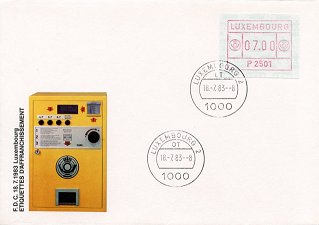 |
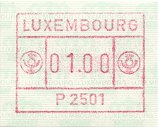 |
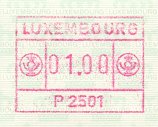 |
Different ink cartridges were used on these distributors, during its period in service. The result was ATMs with the same design, but printed in different shades of red. |
One year after the installation of the first distributor, on July 10th 1984, three new machines were installed in different post offices across the country (P 2502, P 2503 and P 2504), and a further group of three in May 1986 (P 2505, P 2506 and P 2507).
 |
 |
 |
P 2502 - 10.7.1984
Luxembourg Gare - Outside P.O. |
P 2503 - 10.7.1984
Esch-sur-Alzette |
P 2504 - 10.7.1984
Mersch |
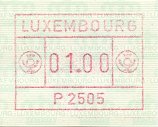 |
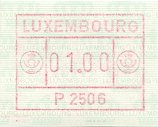 |
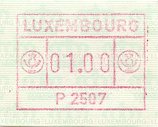 |
P 2505 - 22.5.1986
Luxembourg Gare - Inside P.O. |
P 2506 - 22.5.1986
Luxembourg Centre - Inside P.O. |
P 2507 - 22.5.1986
Ettelbruck |
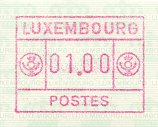 |
From March 16th 1992, following the installation of five new Frama FE 1310 distributors (pictured below), P&TLuxembourg decided to standardise the printing on the 12 machines in service, by replacing the machine code printed on the lower frame of the ATMs with the common text 'POSTES' (width 14.5 mm). |
 |
In November of the same year, the printing plates of the two distributors installed in the Luxembourg-Centre post office were changed, leading to a printing variety -a new ATM issue-, in which the POSTES lower text became wider (17 mm.). This same plate design was also used in later Frama distributors. |
With the arrival of the Euro, the distributors were not updated to the new currency, and all Frama machines were taken out of service in late 2001.
| The Ascom Monétel - L.S.A. issues |
 |
On February 18th 1997, P&TLuxembourg installed, in the Auchan shopping centre, in Luxembourg-Kirchberg, a new type of ATM vending machine called L.S.A. (Livre Service Affranchissement), manufactured by the French company Ascom Monétel.
The new postal kiosk was fitted with a scale allowing the user to obtain an ATM with a face value, according to the weight, destination and shipping method of the postal item. It was also possible to obtain ATMs with different basic programmed postage values, and any other face value starting from 1 franc, when the distributor does not have the right coins for change. In this case, the machine offers the user a stamp.
After a trial of some months, another two machines were installed, that were in service until late 2001. These postal kiosks were not converted to the new European currency. |
| Distributors Frama FE1310 & Ascom Monétel L.S.A. in Luxembourg |
For the ATM impression, the Ascom Monétel - L.S.A. postal kiosks used rolls of self-adhesive labels manufactured, in France, by the Imprimerie des Timbres Poste. The size of the ATMs is 80 x 30 mm.
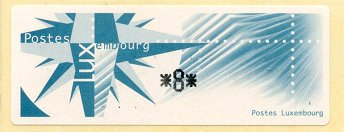 |
The design of the first issue is by Dominique Henry. It includes a representation of a compass on the left, and a stack of mail on the right. |
| The Ascom Monétel - L.S.A. postal kiosks printed the face value using black ink cartridges. |
 |
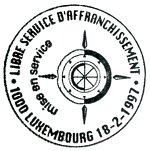
|
Pictorial official cover for the 'Mise en service' (putting into service) of the L.S.A. distributor, and detail of the first day postmark. |
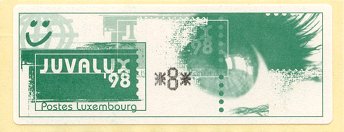 |
The second and last ATM issue, from the L.S.A. postal kiosks, commemorates the World Philatelic Exhibition Juvalux'98, which specialised in youth philately and postal history, and was held in Luxembourg from June 18th to 21st 1998. The design is also by Dominique Henry. |
| The issue could be obtained from the Ascom Monétel - L.S.A. distributor installed in the exhibition premises. |
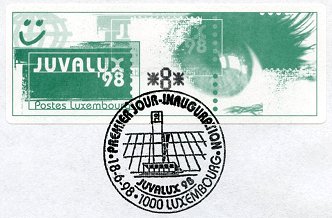 |

|
The postmark for the Juvalux'98 inauguration, and first day of the ATM issue, is illustrated with a picture of Luxexpo, the congress and exhibition centre in Kirchberg, where the exhibition was held. |
| 2012. The return of the ATM to the Grand Duchy |
 |
After 14 years without new ATM issues, and 11 years since the older distributors were removed from service, P&TLuxembourg ran a public pilot using a postal kiosk manufactured by the Dutch company Hytech International.
The new equipment was installed, on December 4th 2012, in the hall of the Luxembourg-Gare post office (images). |
The machine installed was a SelfPost postal kiosk, similar to those purchased in 2012 by Royal Mail in the UK (see article >, also published in VARIABLE 26), customized with the colours and the logo of P&TLuxembourg, but with some important changes.
Unlike the Postalvision equipment developed for Royal Mail and mainly conceived for philatelic use, this postal kiosk is intended to be used by customers who wish to perform different basic franking operations, without waiting in the usual queues at the post offices.
The machine does not offer direct purchase buttons with programmed basic postage values. The SelfPost postal kiosk has an additional unit, at the right hand side, with a scale and a mailbox. For each stamp, the user must place the postal item on the scale, select the language (Luxembourgish, French, German, English or Portuguese) on the large format touch screen, then the country of destination. The system then shows the different services or shipment methods available, and the corresponding postage rate (see images below). After acceptance of the conditions, the system shows the total to pay. Payment must be made by bank card only, through a payment unit that, this time, is not integrated into the main postal kiosk design, but added to the right of the main unit. |
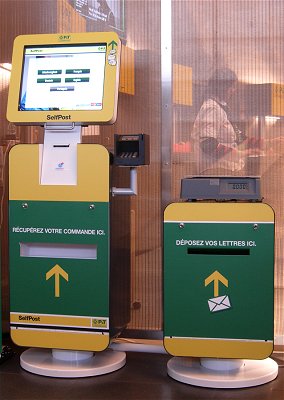 |
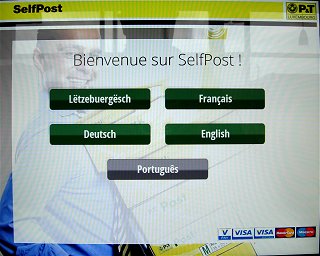 |
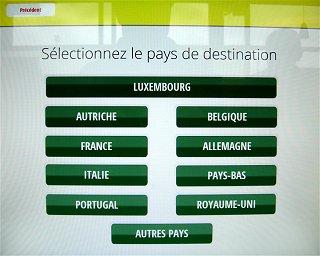 |
For the ATM issue, the postal kiosk uses rolls of thermal self-adhesive labels, manufactured by the well known Dutch security printing company Enschedé Stamps. The size of the ATMs is 56 x 25 mm.
 |
The composition is by Jean-Philippe Janus, with a pale grey background with the continuous text POSTES LUXEMBOURG, and the image of the Grand-Duc Henri, the current head of state of the Grand Duchy of Luxembourg to the right. The image used is the same engraving created by the Belgian artist Guillaume Broux for the current definitive stamps series. |
Maximum card S.A.R. Le Grand-Duc Henri of Luxembourg,
with the new ATM and the first day postmark |
 |
The Hytech-SelfPost postal kiosk, equipped with direct thermal printers, prints the service or shipment indicator and the face value in the upper left corner (Lettre standard and 0.60 EUR in the lower left image), and a unique code for each stamp at the lower left. This 20-digit code (20121204151801011826 in the image) contains all the information about the stamp: 2012 is the year of issue, 1204 for the month and day (December 4th, first day of issue), 1518 for the time of issue, 01 for the postal kiosk number, and finally 011826 indicates the transaction number (not specifically for this equipment, but sequentially with other P&TLuxembourg equipment and services).
The philatelic service also sells this issue, although not printed by the postal kiosk, but with a Hytech desktop printer, dated for the first day of issue (2012 1204), at 8 am (0800), and only with the basic value for domestic mail (images below, right). |
As can be seen in the images, it is possible to distinguish the origin of each stamp according to the position of the face value, which in the case of the philatelic service, is more to the upper left corner of the stamps. Other than this, both postal kiosks and desktop printers, use a different print font, so it is possible to recognize up to three different print varieties for this issue - one from postal kiosks and two from the machines used by the philatelic service. Surprisingly, the philatelic service produced a reissue using a smaller printing font for the face value (13.50 mm long for the original edition, and 11.50 mm. for the reissue).
For the philatelic service stamps, the lower code has 21 digits (instead of 20), all have the same information about the date and time of issue (2012 1204 0800), and the machine number (4 or 40), and the sequential operational number - 2956 in the first image, 16851 in the second (reissue) stamp.
| SelfPost postal kiosks |
Philatelic service - Hytech desktop printer |
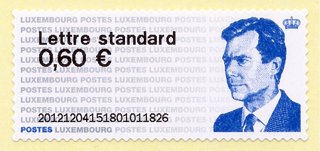 |
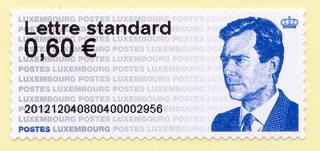 |
| |
 |
On the date of putting the new postal kiosk into service, it was possible to obtain ATMs with three different service indicators, corresponding to the three formats of letters established by P&TLuxembourg. Lettre standard for standard letters weighing up to 50 g, Lettre non standard for non-standard sized letters and a maximum weight of 500 g., and Maxi Lettre for other shipments that do not meet the above conditions, or weighing between 500 g. and up to 2 k.
A fourth option was also available, Quality Pack, for domestic and international parcels. Selecting this option does not print an ATM, but a special large size postage label (see image at the end of this section). |
 |
 |
Strip with the set of ATMs with the 3 postage indicators available on the first day of issue, in the first weight step for domestic mail, and the receipt. It can be seen in the last 6 digits of the ATMs code, the transaction number is not continuous in the 3 stamps, but sequentially generated with other P&TLuxembourg services. |
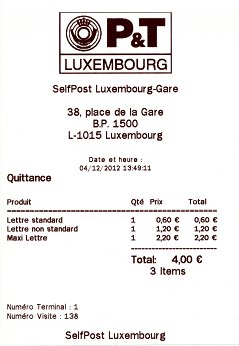 |
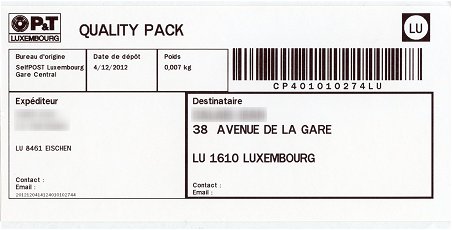 |
As in the postal kiosks in service in the UK, the Hytech SelfPost postal kiosk in Luxembourg is also equipped with three direct thermal printers. But here only one is used for the ATM impression, the second for receipts, and the third for parcel franking labels. |
| Two months after the installation of the first SelfPost postal kiosk (see article and VARIABLE 27), P&TLuxembourg installed a second station on February 6th 2013, in the lobby of the main post office - Luxembourg-Centre. |
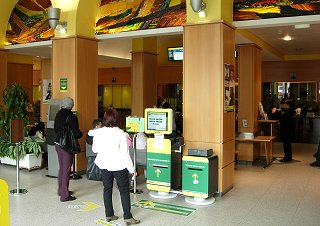 |
 |
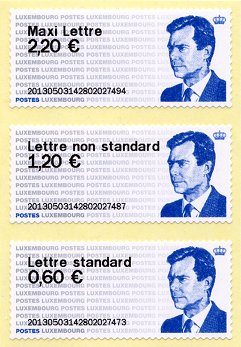 |
The SelfPost station is identical to the one installed in the Luxembourg-Gare post office. It works with the same software, and uses the same type of self-adhesive labels.
The stamps issued by this machine are numbered 02 within the 20-digits code at the lower left corner (20130503142802... at the ATMs of the set). |
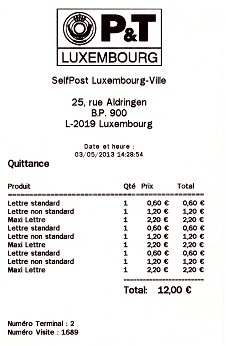 |
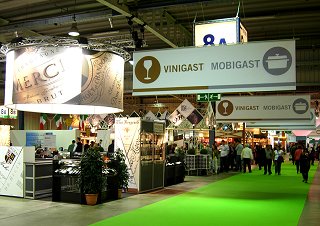 |
LUXEXPO is the largest exhibition and congress centre in Luxembourg-Kirchberg, and every year hosts many different commercial venues. Among the most important are the spring and autumn fairs (Foire de printemps and Foire d'automne), showing the main business sectors of the country.
In 2013, the 101st Foire de printemps was held from May 3rd to 10th, with an area of over 30,000 m2 and over 400 exhibitors, arranged in 5 sections devoted to food and wine, furniture and appliances, gardens, fashion and beauty, and services, as well as a show dedicated to electric vehicles. |
In the area dedicated to services, companies and public institutions working in the country offer their services to visitors. One of the participating companies was P&TLuxembourg, with a large stand divided into different zones, displaying the different business sections of the company. A third SelfPost postal kiosk (code 03 on the ATMs) was temporarily installed in the area devoted to postal services, and used as an introduction to this new equipment, which will be rolled out by post offices across the country after completion of the test period.
| P&TLuxembourg also took advantage of the temporary installation of this new SelfPost station to introduce new software to deal with some of the complaints and comments received from users during the first few weeks that the equipment had been in service. |
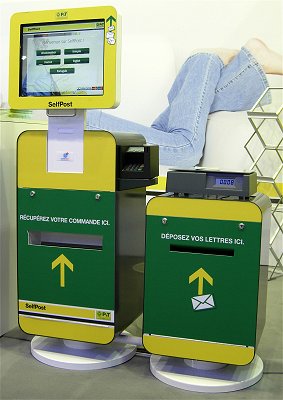 |
 |
In the new program, they introduced the Portuguese language in the selection menu (in fact, the Portuguese make up 13% of the total population), and they added the 'Buy Postage' option (see screen below, left). Selecting this new option, the scale is not used. The user is required to choose the zone of the postal item, then the weight step, and finally the quantity of stamps required. The ATMs printed using this new option include the texts 'Luxembourg', 'Europe' and 'Reste du Monde', depending on the zone selected by the user.
 |
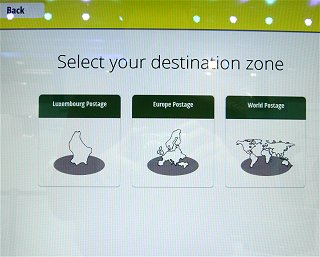 |
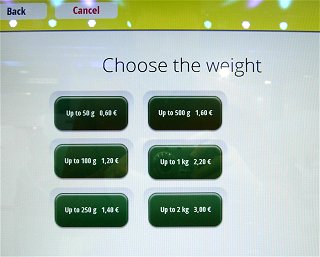 |
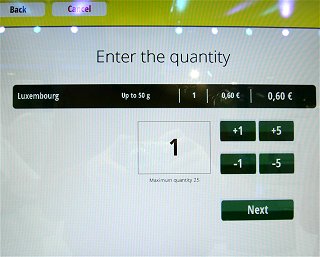 |
Selecting the 'Weight & Post' option from the main menu, the system leads to the original application for which, and for each stamp, the user must place the postal item on the scale and select the destination. The system then shows the different shipment options available, and the corresponding postage rate. The ATMs printed using this option still include the three service indicators, corresponding to the three formats of letters established: 'Lettre standard', 'Lettre non standard', and 'Maxi Lettre' (see article and VARIABLE 27).
This new software was also installed, from May 8th 2013, in the other two SelfPost postal kiosks in service.
 |
 |
From May 3rd 2013 in kiosk number 3, and from the installation of new software on the other SelfPost postal kiosks, it is possible to obtain ATMs with the 6 different texts or indicators.
In the ATMs, the code at the bottom indicates the year of issue (2013), the date (May 3rd - 0503), the time of issue (1730), the postal kiosk number (03) and the transaction number. |
 |
 |
Below, a first day cover of the postal kiosk number 03, and the new indicators.
Right, first day receipt of postal kiosk 03 installed in the Foire de Printemps (SelfPost Mobile), for the joint purchase of the 6 ATMs with different texts. |
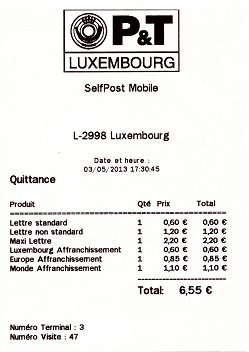 |
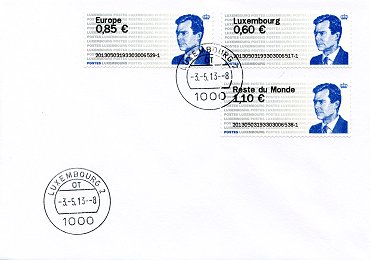 |
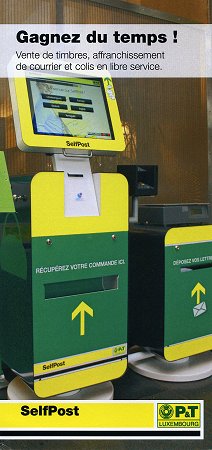 |
After the Foire de Printemps, in mid-May, the new SelfPost station, number 03, was installed in the PostShop located in the 'La Belle Etoile', the largest shopping centre in Luxembourg.
At the end of the successful trial period, and over the following months, P&T Luxembourg installed another nine SelfPost postal kiosks in post offices scattered around the country, giving a total of twelve machines in service.
01 - Luxembourg - Gare (4/12/2012)
02 - Luxembourg - Ville (6/02/2013)
03 - Bertrange - Post office in the shopping center 'La Belle Étoile' (13/05/2013)
04 - Luxembourg - Cloche d'Or (20/06/2013)
05 - Luxembourg - Kirchberg (21/06/2013)
06 - Mersch post office (27/06/2013)
07 - Junglinster - Post office in the shopping center 'Laangwiss' (28/06/2013)
08 - Helfent - Bertrange - Post office in the shopping center 'City Concorde' (9/07/2013)
09 - Esch-sur-Alzette post office (5/07/2013)
10 - Dudelange post office (19/07/2013)
11 - Ettelbruck post office (4/07/2013)
12 - Diekirch post office (14/08/2013) |
2014 - POST Luxembourg and the new ATM issue
'Coat of arms of Luxembourg'
Article > |
© J. Jove - M. Sans. ATEEME. Variable value stamps study group. All rights reserved
This page was created in 2002 and last updated:
08.01.15
. English edition last rewritten by S. Goodman (05.01.2015)
|










































